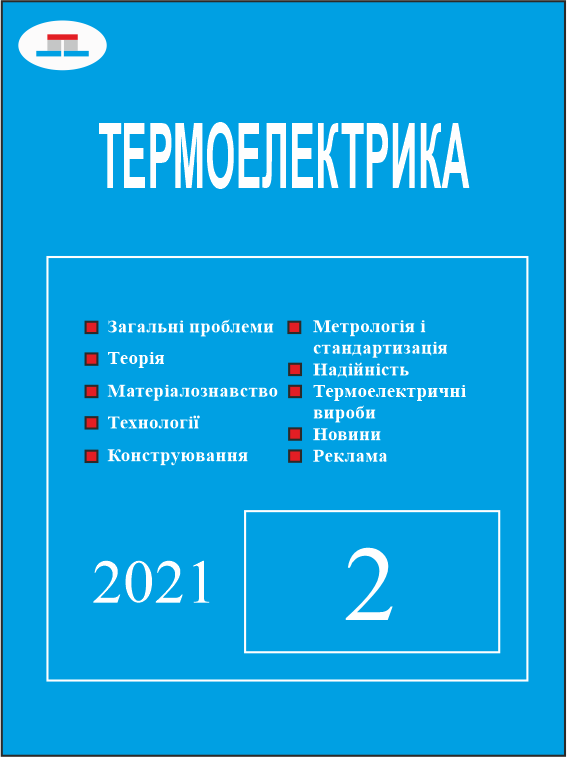Дослідження властивостей нового термоелектричного матеріалу Lu1-xScxNiSb
Ключові слова:
електронна структура, електроопір, коефіцієнт термоЕРСАнотація
Досліджено кристалічну та електронну структури, термодинамічні, кінетичні, енергетичні та магнітні властивості термоелектричного матеріалу Lu1-xScxNiSb за температур Т = 80 – 400 К. У залежності від концентрації легуючого компоненту у твердому розчині Lu1-xScxNiSb встановлено різні механізмами входження атомів Sc у матрицю напівпровідника, що приводить до різних швидкостей генерування структурних дефектів акцепторної та донорної природи. Співвідношення концентрацій наявних дефектів донорної та акцепторної природи визначає у Lu1-xScxNiSb положення рівня Фермі εF та механізми провідності. Досліджений твердий розчин Lu1-xScxNiSb є перспективним термоелектричним матеріалом. Бібл. 18, рис. 8.
The crystalline and electronic structures, thermodynamic, kinetic, energy and magnetic properties of the thermoelectric material Lu1-xScxNiSb at temperatures T = 80 – 400 K have been studied. Depending on the concentration of the alloying component in the solid solution Lu1-xScxNiSb, different mechanisms of Sc atoms entering the semiconductor matrix have been established, which leads to different rates of generation of structural defects of acceptor and donor nature. The ratio of the concentrations of existing defects of donor and acceptor nature determines the position of the Fermi level εF and the conduction mechanisms in Lu1-xScxNiSb. The investigated solid solution Lu1-xScxNiSb is a promising thermoelectric material. Bibl. 18, Fig. 8.
Посилання
Karla I., Pierre J., Skolozdra R.V. (1998). Physical properties and giant magnetoresistance in RNiSb compounds. J. Alloys Compd., 265, 42–48.
Romaka V.V., Romaka L., Horyn A., Rogl P., Stadnyk Yu., Melnychenko N., Orlovskyy M., Krayovskyy V. (2016). Peculiarities of thermoelectric half-Heusler phase formation in Gd-Ni-Sb and Lu-Ni-Sb ternary systems. J. Solid State Chem., 239, 145–152.
Wolańska I., Synoradzki K., Ciesielski K., Załęski K., Skokowski P., Kaczorowski D. (2019). Enhanced thermoelectric power factor of half-Heusler solid solution Sc1-xTmxNiSb prepared by high-pressure high-temperature sintering method. Materials Chemistry and Physics, 227, 29–35.
Romaka V.A, Stadnyk Yu., Romaka L., Krayovskyy V., Нoryn A., Klyzub P., Pashkevych V. (2020). Study of structural, electrokinetic and magnetic characteristics of the Er1-xZrxNiSb Semiconductor. J. Phys. Chem. Sol. State, 21(4), 689-694.
Romaka V.A., Stadnyk Yu.V., Romaka L.P., Pashkevych V.Z., Romaka V.V., Horyn A.M., Demchenko P.Yu. (2021). Study of structural, thermodynamic, energy, kinetic and magnetic properties of thermoelectric material Lu1-xZrxNiSb. J. Thermoelectricity, 1, 32–50.
Romaka V.A, Stadnyk Yu., Romaka L., Krayovskyy V., Klyzub P., Pashkevych V., Нoryn A., Garanyuk P. (2021). Synthesis and Electrical Transport Properties of Er1-xScxNiSb Semiconducting Solid Solution. J. Phys. Chem. Sol. State, 22(1), 146-152.
Romaka V.V., Romaka L., Horyn A., Stadnyk Yu. (2021). Experimental and theoretical investigation of the Y–Ni–Sb and Tm–Ni–Sb systems, J. Alloys Compd., 855, 157334–12.
Anatychuk L.I. (1979). Termoelementy i termoelectricheskiie ustroistva. Spravochnik. [Thermoelements and thermoelectric devices. Reference book]. Kyiv: Naukova dumka [in Russian].
Romaka V.V., Romaka L.P., Krayovskyy V.Ya., Stadnyk Yu.V. (2015). Stanidy ridkisnozemelnykh ta perekhidnykh metaliv [Stannides of rare earth and transition metals] Lviv: Lvivska Polytechnika [in Ukrainian].
Romaka V.A., Stadnyk Yu.V., Krayovskyy V.Ya., Romaka L.P., Guk O.P., Romaka V.V., Mykyuchuk M.M., Horyn A.M. (2020). Novitni termochutlyvi materialy ta peretvoriuvachi temperatury [New thermosensitive materials and temperature converters]. Lviv, Lvivska Polytechnika [in Ukrainian].
Roisnel T., Rodriguez-Carvajal J. (2001). WinPLOTR: a windows tool for powder diffraction
patterns analysis. Mater. Sci. Forum, Proc. EPDIC7 378–381, 118–123.
Babak V.P., Shchepetov V.V. (2018). Wear resistance of amorphous-crystalline coatings with lubricants. J. Friction and Wear, 39(1), 38–43.
Akai H. (1989). Fast Korringa-Kohn-Rostoker coherent potential approximation and its application to FCC Ni-Fe systems. J. Phys.: Condens. Matter., 1, 8045–8063.
Moruzzi V.L., Janak J.F., Williams A.R. (1978). Calculated electronic properties of metals. NY: Pergamon Press.
Savrasov S.Y. (1996). Linear-response theory and lattice dynamics: A muffin-tin-orbital approach. Phys. Rev. B, 54(23), 16470–16486.
Momma K., Izumi F. (2008). VESTA: a three-dimensional visualization system for electronic and structural analysis. J. Appl. Crystallogr., 41, 653–658.
Shklovskii B.I. and Efros A.L. (1984). Electronic properties of doped semiconductors NY: Springer; (1979) Moscow: Nauka.
Mott N.F., Davis E.A. (1979). Electron processes in non-crystalline materials. Oxford: Clarendon Press.


